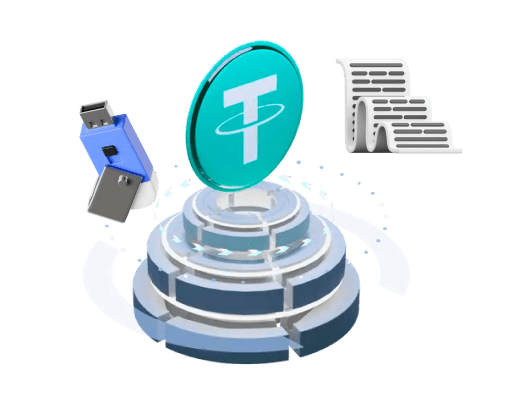USDT Wallet:
5 Best Ways to Store Tether


Tether (USDT) is the first and most widely used stablecoin, pegged 1:1 to the US dollar. As the third-largest cryptocurrency by market capitalization, its price stability makes it a popular choice for traders. Unlike other volatile cryptocurrencies, USDT maintains a steady value while operating on various blockchain networks, offering benefits like fast transfers and access to decentralized finance (DeFi). This guide explores the different types of crypto wallets available for securely storing your USDT.
How to Choose the Best Tether (USDT) Wallet
When selecting a wallet for Tether, several key factors should guide your decision. First, ensure the wallet explicitly supports the specific version of USDT you hold (e.g., ERC-20 on Ethereum, TRC-20 on Tron). Security is paramount; look for features like two-factor authentication, biometric access, and a clear backup and recovery process using a seed phrase. Usability is also important—a clean interface and multi-platform support can greatly improve your experience. Finally, always research the wallet's reputation by reading user reviews and checking its security history.
Key Types of Tether Wallets
You can use several types of wallets to store Tether, each with its own balance of security and convenience.
Desktop Wallets
Desktop wallets are applications installed on a PC or laptop. They provide a high level of security because your private keys are stored directly on your computer, giving you full control. This means you can only access your funds from the device where the wallet is installed. However, your computer's security is critical, as viruses or malware could compromise your assets. Examples include Exodus, Atomic Wallet, and Electrum.
Mobile Wallets
A mobile wallet is an app installed on a smartphone, offering convenience for on-the-go transactions. The security of a mobile wallet largely depends on your device's security. Private keys are stored on the phone, so if the device is lost or stolen, your funds could be at risk. Enhance security by using PIN codes, payment passwords, and biometric features like fingerprint or face ID. Always back up your seed phrase when setting up the app. Popular examples are Trust Wallet, Trustee, and imToken.
Online (Web) Wallets
Online wallets are accessible through a web browser, allowing you to log in from any device with an internet connection. This method is convenient for managing small amounts of USDT for short periods but is generally considered the least secure, as your keys may be managed by a third party. This category includes wallets on cryptocurrency exchanges. Examples include Guarda and Lumi Wallet.
Hardware Wallets
Hardware wallets are physical devices that store your private keys offline, providing the highest level of security. You only connect the device to the internet when you need to authorize a transaction. Since they are protected by a PIN and a recovery phrase, your funds remain safe even if the device is lost or stolen. These wallets come in various forms, such as USB drives or cards. Leading examples include Ledger, Trezor, and SafePal.
Paper Wallets
A paper wallet is a form of cold storage where your public and private keys are printed on a piece of paper. This method is completely free and highly secure because it keeps your keys entirely offline. However, it requires careful storage, as the paper is vulnerable to physical damage from water, fire, or tearing, which could make your keys unreadable.
Conclusion on USDT Storage
Tether's role as a dollar-pegged stablecoin makes it an essential tool for many cryptocurrency users, allowing them to hedge against market volatility without leaving the digital asset ecosystem. Understanding the different storage options—from highly secure hardware wallets to convenient mobile apps—is crucial for managing your USDT effectively. By choosing a wallet that aligns with your security needs and usage habits, you can protect your assets with confidence.
Frequently asked questions
-
How can I buy USDT?
USDT can be purchased on most major cryptocurrency exchanges. You can typically buy it using fiat currency (like USD or EUR) through bank transfers or credit/debit cards, or by trading it for other cryptocurrencies like Bitcoin or Ethereum. -
What is the best wallet for storing USDT?
For long-term storage and maximum security, hardware wallets like Ledger or Trezor are widely considered the best option. They keep your private keys completely offline, protecting them from online threats. -
Where should I store my private key?
A private key should never be stored digitally on a device connected to the internet. The most secure methods are offline, such as within a hardware wallet or written down as a seed phrase on paper and stored in a safe, private location. -
Can I store USDT in a mobile app?
Yes, many mobile wallet apps like Trust Wallet or Exodus support USDT. They offer a good balance of convenience for daily use and security, provided you protect your device and safely back up your seed phrase. -
What type of crypto wallet should I choose?
The right wallet depends on your priorities. If you prioritize security for large amounts, choose a hardware wallet. If you need frequent access and convenience for smaller amounts, a mobile or desktop wallet is a suitable choice. -
What are cold and hot wallets?
A cold wallet is a storage method that is not connected to the internet, such as a hardware or paper wallet, offering high security. A hot wallet is connected to the internet, like a mobile or web wallet, offering convenience for transactions. -
What are custodial and non-custodial wallets?
A custodial wallet is one where a third party, such as an exchange, holds your private keys for you. A non-custodial wallet gives you full control and responsibility over your private keys and, therefore, your funds.
Our website uses cookies. Our Cookie Policy
